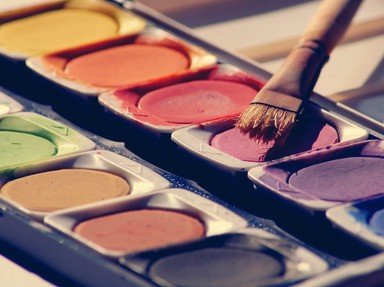Quiz Answer Key and Fun Facts
1. The idea of producing an impression of a three-dimensional object when the image is part of a flat surface is not new. This example was unearthed in an Italian city that was famously buried by a volcanic eruption in 79 CE. Which of these is the site of the House of Julia Felix, where it was found?
2. The remarkable feature of this painting is not the portrait, although that is fairly realistic, it is the fly on the frame. Look closer if you didn't notice it! The subject of this painting by the Flemish painter Petrus Christus is a monk from an order who usually live enclosed in monasteries called charterhouses. What is the name of this painting?
3. 'Still Life with Partridge and Gloves' is one of the first examples of trompe-l'oeil painting (in a complete work) since antiquity. It was produced near the end of the 15th century by an Italian artist who moved from Venice to Germany in 1500, becoming the first significant Italian Renaissance artist to work in the northern part of Europe. Which of these was it?
4. This 'Self-Portrait', dating from around 1650, can be seen in Amsterdam's Rijksmuseum. It features a number of items which appear to be projecting outwards from the painting into space, including the male figure, the pipe he is holding/smoking, the book he is reading, the curtains hanging on the right side of the window through which the previous items are seen, and the corner of the label bearing the artist's name which is under the window. What artist's name is indicated on the label?
5. The building shown here uses a trompe-l'oeil fresco to make a low vaulted ceiling appear to be under a spacious dome. What kind of building did the Italian Jesuit brother Andrea Pozzo decorate with this fresco in 1703?
6. This painting by the Swiss artist Henri Fuseli (1741-1825) appears to show a drawing made on a piece of paper that has been hung on a wooden wall, while it is actually an oil painting on canvas. Its subject matter is very different from that for which Fuseli is best known. Which of these is his most common theme?
7. This window, designed by Richard Morris Hunt and constructed by Eugene Stanislas Oudinot, was installed in the house of Henry G Marquand, creating the illusion of a country estate for a building in the middle of Manhattan. What is the name given to the technique in which small pieces of colored glass are assembled to produce a picture window?
8. Sculptors also sometimes create illusions with their work. Here the woman's head and shoulders seem to be covered with a transparent veil, through which her features can be seen, but it is all a single piece of marble. What is the name of a sculpture, such as this one, that only shows the head and shoulders of the subject?
9. Students on the campus of California State University (Chico) may be somewhat taken aback the first time they see the wall of Taylor Hall, which has been painted so as to look as if it is in a state of collapse, with classical columns inside the building. What term is used to describe a painting made directly to the surface of a wall or ceiling, of which this is an example?
10. The tomb of ballet dance Rudolph Nureyev is covered with what appears to be an oriental carpet, but which is actually composed of many small stones fit together to make a solid decoration for the tomb. What is the name for this art form?
Source: Author
looney_tunes
This quiz was reviewed by FunTrivia editor
ponycargirl before going online.
Any errors found in FunTrivia content are routinely corrected through our feedback system.
